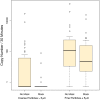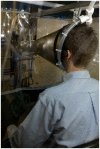Influenza virus aerosols in human exhaled breath: particle size, culturability, and effect of surgical masks
- PMID: 23505369
- PMCID: PMC3591312
- DOI: 10.1371/journal.ppat.1003205
Influenza virus aerosols in human exhaled breath: particle size, culturability, and effect of surgical masks
Abstract
The CDC recommends that healthcare settings provide influenza patients with facemasks as a means of reducing transmission to staff and other patients, and a recent report suggested that surgical masks can capture influenza virus in large droplet spray. However, there is minimal data on influenza virus aerosol shedding, the infectiousness of exhaled aerosols, and none on the impact of facemasks on viral aerosol shedding from patients with seasonal influenza. We collected samples of exhaled particles (one with and one without a facemask) in two size fractions ("coarse">5 µm, "fine"≤5 µm) from 37 volunteers within 5 days of seasonal influenza onset, measured viral copy number using quantitative RT-PCR, and tested the fine-particle fraction for culturable virus. Fine particles contained 8.8 (95% CI 4.1 to 19) fold more viral copies than did coarse particles. Surgical masks reduced viral copy numbers in the fine fraction by 2.8 fold (95% CI 1.5 to 5.2) and in the coarse fraction by 25 fold (95% CI 3.5 to 180). Overall, masks produced a 3.4 fold (95% CI 1.8 to 6.3) reduction in viral aerosol shedding. Correlations between nasopharyngeal swab and the aerosol fraction copy numbers were weak (r = 0.17, coarse; r = 0.29, fine fraction). Copy numbers in exhaled breath declined rapidly with day after onset of illness. Two subjects with the highest copy numbers gave culture positive fine particle samples. Surgical masks worn by patients reduce aerosols shedding of virus. The abundance of viral copies in fine particle aerosols and evidence for their infectiousness suggests an important role in seasonal influenza transmission. Monitoring exhaled virus aerosols will be important for validation of experimental transmission studies in humans.
Conflict of interest statement
BJC has received research funding from MedImmune Inc., and consults for Crucell MV. The authors declare that no other competing interests exist.This does not alter our adherence to all PLoS Pathogens policies on sharing data and materials.
Figures


References
-
- Johnson GR, Morawska L (2009) The Mechanism of Breath Aerosol Formation. J Aerosol Med Pulm Drug Deliv 22: 229–37. - PubMed
-
- Committee on Respiratory Protection for Healthcare Workers in the Workplace Against Novel H1N1 Influenza A (2009) Respiratory Protection for Healthcare Workers in the Workplace Against Novel H1N1 Influenza A: A Letter Report. Washington, DC: Institute of Medicine. 60 p.
-
- Atkinson MP, Wein LM (2008) Quantifying the routes of transmission for pandemic influenza. Bull Math Biol 70: 820–867. - PubMed
-
- Nicas M, Jones RM (2009) Relative contributions of four exposure pathways to influenza infection risk. Risk Anal 29: 1292–1303. - PubMed
Publication types
MeSH terms
Substances
Grants and funding
LinkOut - more resources
Full Text Sources
Other Literature Sources
Medical

